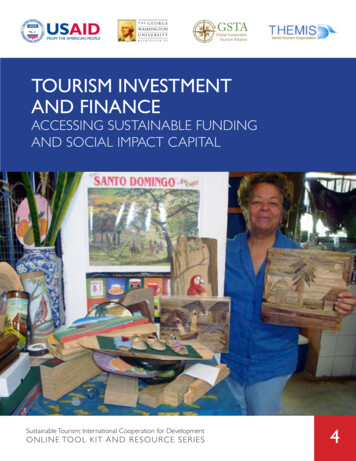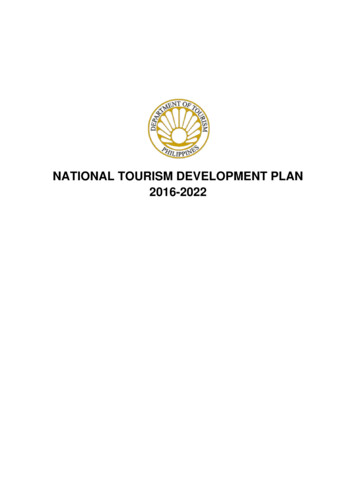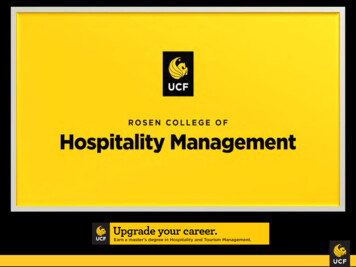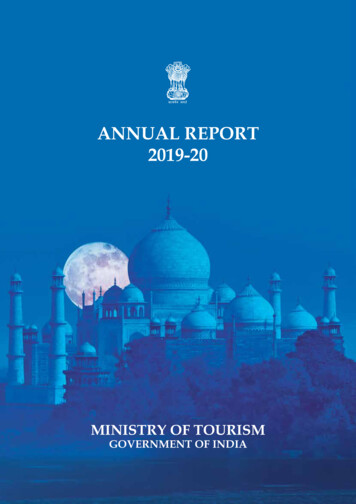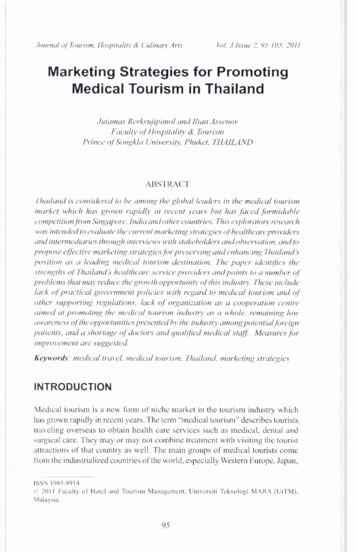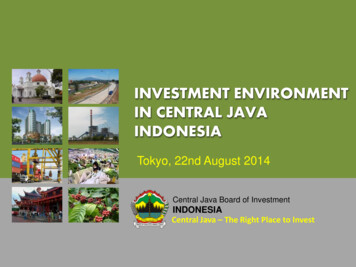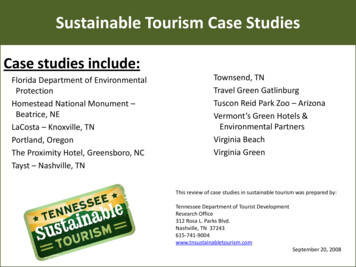
Transcription
Sustainable Tourism Case StudiesCase studies include:Florida Department of EnvironmentalProtectionHomestead National Monument –Beatrice, NELaCosta – Knoxville, TNPortland, OregonThe Proximity Hotel, Greensboro, NCTayst – Nashville, TNTownsend, TNTravel Green GatlinburgTuscon Reid Park Zoo – ArizonaVermont’s Green Hotels &Environmental PartnersVirginia BeachVirginia GreenThis review of case studies in sustainable tourism was prepared by:Tennessee Department of Tourist DevelopmentResearch Office312 Rosa L. Parks Blvd.Nashville, TN mber 20, 2008
Case Studies: Sustainable Certification ProgramsVirginia GreenVoluntary certification program to reduce environmental impact of VA’stourism industry. Coordinated by VA Department of Environment, VA TourismCorporation, and VA Hospitality and Travel Association.Goal: Reduce environmental impacts of tourism industry, increaseenvironmental awareness of the industry and its customers, make the tourismindustry more profitable through the use of green practices.Benefits to members: Listed on VA Green website and searchable through VAis for Lovers, VA Green Certificate for display, use of VA Green logo, VA Greenprofile of facility, increase patronage by environmental groups andenvironmentally-aware customers , save through cost savings measures.Results! Assuming these facilities achieve similar results, 100 Virginia GreenLodging facilities should achieve annually: 15 million gallons of reduced waterconsumption, 100 million lbs. of reduced CO2 emissions, 3500 tons of reducedsolid waste generation.http://www.virginia.org/green/Florida Dept. of EnvironmentalProtectionVoluntary, non-regulatory program that assist Florida’s industryand citizens in protecting the environment.Coordinated by the Florida Dept. of Environmental Protection.Sustainable Initiatives include: The Clean Marina Program, theFlorida Green Lodging Program and the Florida PollutionPrevention Program.Benefits to members: on-site assessments, consultations,speakers and workshops, all at no cost to citizens ororganizations.Goal: Meet the needs of the present population withoutcompromising resources for future l.htmwww.tnsustainabletourism.com
Case Studies: Sustainable DestinationsTownsend, TNDesignated as a Preserve America Community.Blount County is the only “county” in Tennessee to begiven this designation.Destination website offers visitors low impact vacations.Website ranks #5 in Google search for “low impactvacations.”Goal: Establish a sustainable tourism program focused onBlount County’s heritage and low-impact-vacation.htmlTravel Green Gatlinburgwww.tnsustainabletourism.comVoluntary program recognizing member businesses committed tocontinuously improving their operations in order to reduce theirenvironmental impact.Coordinated by the Gatlinburg Chamber of Commerce.Program is the product of a group of concerned business owners andcitizens of the City of Gatlinburg who are dedicated to keepingGatlinburg a Great Place to Live, Work and Visit.Goal: Assist members to evaluate their operations, set goals, and takespecific actions towards environmental, social, and economicsustainability.Benefits: Participants receive a decal to display to let visitors know thatthey are taking steps to make Gatlinburg more environmentally friendly,display the “Gatlinburg Goes Green” icon next to their listing ongatlinburg.com, provided with information regarding environmentallyfriendly products to use in their place of business which should be moreeconomically feasible than over the counter reen/
Case Studies: Sustainable DestinationsVirginia BeachDeclared Virginia’s first green destination by VA Green in July 2008.VA Beach Green Hospitality Team, a grassroots group of local hospitalitybusinesses and organizations, surpassed VA Green’s goal to become agreen destination.Green destination offers 20 restaurants, 16 hotels, 4 attractions, 5 events,and the VB Convention Center - all certified as VA Green participants.Destination aggressively pursues conservation efforts with initiatives suchas hybrid-electric shuttle buses in the resort area and an oceanfrontrecycling program.Website provides information on what visitors can do for an eco-friendlyvacation and guidelines for meeting planners on how to “green” theirmeeting.Goal: Establish Virginia Beach’s hospitality industry as an environmentalleader and bring awareness to the Virginia Green statewide entravel/Portland, OregonNamed America’s top green city by Popular Science magazine.Ranks at the top of Bicycling Magazine best cycling cities.50% of the city’s power comes from renewable sources.25% of the workforce commutes by bike, carpool or publictransportation.City has the nation’s highest percentage of workers who commuteby bike – 3.5%.35 buildings certified by the U.S. Green Building Council.Portland’s Goal: To be as sustainable a city as possible, thatmeans socially, environmentally, and s/www.tnsustainabletourism.com
Case Studies: Sustainable HotelsVermont's Green Hotels & Env. PartnersVoluntary program provides assistance to innkeepers using soundenvironmental management practices to reduce their impacts onthe environment, improve their bottom line and satisfy customerdemand for environmentally conscious lodging establishments.64 Green Hotels & 9 VBEP business have joined the program.Results! Saved Gallons of H20 - 4,774,429; Gallons of Bleach 2,651; Lbs. Detergent 24,381; KWH 1,470,918; Recycled 413,312lbs.; Fuel Oil 15,275.Benefit to members: Profit from increased resource efficiency andreduced waste disposal costs, region-wide marketing as anenvironmental leader, free technical assistance, gain increasedmarketshare from environmentally conscious guests, develop andstrengthen guest loyalty by being involved with "greening" efforts,and peace of mind knowing business is doing its part to preservethe lThe Proximity Hotel – Greensboro, NCDesignated as one of the “greenest” hotels in the country.Rated highest "Eco Getaway" by Outside Magazine.America’s greenest (indoor) spot to spend the night by MetropolitanHome.First hotel in the United States to strive for the highest LEED certification.Utilizes sun’s energy to heat hot water with 100 solar panels covering the4,000 sq. ft. of rooftop (enough hot water for 100 homes). This heatsaround 60% of the water for both the hotel and restaurant.Uses 41% less energy than a conventional hotel by using ultra efficientmaterials and the latest construction technology.Connects guests to outdoors by achieving a direct line of sight to theoutdoor environment for more than 97% of all regularly occupied spaces.Recycled 87% of construction waste, diverting 1,535 tons of debris fromlandfills.Uses regional vendors and artists for materials to reduce transportationand packaging.Offers bicycles for guests to ride on the nearby five-mile oximityhotel.com/
Case Studies: Sustainable RestaurantsLa Costa – KnoxvilleCity’s first green restaurant certified by National Green RestaurantAssociation.Uses local meats and veggies and all organic ingredients.Recycles glass, paper, aluminum, plastic, and metal.Kitchen waste composted at Beardsley Community Farm.Lighting is compact fluorescent lighting.Cleaning supplies/chemicals chlorine free, non-caustic, earth friendly.100% Styrofoam-free restaurant: To-go cutlery potato starch based,paper towels from recycled paper products, straws are compostable,to-go boxes recycled paper product, drink cups PLA compostableplastic, to-go coffee cups are recycled paper product andcompostable/biodegradable lid.Energy efficient, low-flow water consumption, noncaustic chemicalsLow-flow aerators on sinks to reduce water reen/tayst Restaurant & Wine Bar NashvilleFirst and only green certified restaurant in Nashville by GreenRestaurant Association.Chef and owner - Jeremy Barlow is a staunch advocate oflocally grown foods and sustainable practices. There’s a reasonmore restaurants are using local food — it just tastes better.All organic or biodynamic wines paired with seasonal springofferings.100% Styrofoam free restaurant using biodegradable to-gocontainers.Replaced paraffin candles with all-natural beeswax/soyproduct.Installed faucet aerators to reduce water use by letourism.com
Case Studies: Sustainable AttractionsTucson’s Reid Park ZooConservation Learning Center LEED Platinum certified.First building in Southern Arizona to be Platinum certified, and second inthe entire State of Arizona.10,000-sq. ft. Learning Center uses 80% less energy than average buildingutilizing solar power panels to produce energy for the building.Recycled/sustainable construction materials: shade-rich design andorientation; recycled steel beams; polystyrene and poured concrete walls;rammed earth construction; scrap cotton and blue-jeans insulation; claybased, low-fume and non-toxic paints; FieldTurf artificial grass; HermanMiller sustainable furniture; bamboo cabinetry and corn-based fabrics;eco-friendly carpet; recycled glass countertops.Water harvesting: rooftop rainwater harvesting; gray water irrigation fromsink water; waterless urinals; pervious concrete (porous design allowsstormwater to flow through and recharge groundwater supplies.)http://www.tucsonzoo.org/conservation 2.html#green buildingHomestead National Monument – Beatrice, NECenter focuses on resource conservation.Landscaping is all native plant species and buffalo grass, which needsminimal water to survive.All trail signs and benches around the center are manufactured fromrecycled materials, and aluminum and plastic containers can berecycled in bins on site.Center’s Maintenance Division uses natural or bio-based chemicals,and paper towels and toilet paper are recycled, as are copier andprinter paper.Hybrid vehicle used for day-to-day operations and all of the center’sdiesel equipment runs on a bio-diesel blend.Homestead’s ranger division active in “Kids in Parks” program, whichfocuses on sustainable issues and the importance of being w.tnsustainabletourism.com
Green Tips for Home:Here are some easy things that you can do, right now, to make a difference, many of which will save you money as well.Turn down the heating: According to the American Council for an Energy Efficient Economy, by turning your home's heating down by 2 degreesin the winter and up by 2 degrees in the summer you can save around 900 kilos of carbon dioxide emissions each year. Fact: For each degreethat you raise the thermostat on an air-conditioning unit, energy consumption is reduced by 3 percent. Changing from 20 degrees to 25 degreesreduces energy consumption by 15 percent and over a year on average saves 1,000 kilos of CO2.Unplug un-used appliance: Even when devices are off and the little red lights aren't glowing, they still use electricity. Fact: According to theUniversity of Strathclyde in the UK, the average household will use 525 kilowatts per year to keep equipment in stand-by mode.Buy energy efficient products: From fridges and cookers to computers and light bulbs, some energy efficient appliances may be more expensiveto buy, but will generally save in energy use and bills in the long run. Compact fluorescent light bulbs use four times less energy, and last eighttimes longer than incandescent light bulbs.Insulate your home properly: Proper loft insulation and boiler lagging can make a great difference to reducing wasted heat in homes and theamount of energy needed to heat them. Weather-sealed windows are also important, just as much for homes that need air-conditioning asheating. Fact: The average American home that has proper weather striped doorways and windows can save 770 kilos of carbon dioxide and 274 per year.Don't wash dishes by hand: A study by the University of Bonn, in Germany found that a fully loaded dishwasher uses only half the energy andone-sixth of the water than hand washing the identical set of dirty dishes. Choose a plant-based detergent as modern dishwashers use moredetergent than hand washing.Recycle, reduce, reuse. Fact: Creating a ton of aluminum cans from scratch takes five times the amount of energy as it would to produce a ton ofrecycled cans.Green Tips for the Office:There are plenty of small steps you can do at work to make a difference.Photocopy and print on both sides of the paper: Fact: If an office building of 7,000 workers recycled all of its office paper waste for a year, itwould be the equivalent of taking almost 400 cars off the road in terms of CO2 emissions. (Source: U.S. Environmental Protection Agency)Turn off your computer screen when leaving your desk: If you're going to be away from your desk for more than 15 minutes, you can savemore than 50 percent of the energy that would have been consumed by your computer in your absence.Encourage environmentally friendly company policies: Implement a recycling program in your office by providing employees with recycling binsfor plastics, paper, cans and glass.Source: CNN.com com
LaCosta -Knoxville, TN Portland, Oregon The Proximity Hotel, Greensboro, NC Tayst -Nashville, TN Townsend, TN Travel Green Gatlinburg Tuscon Reid Park Zoo -Arizona Vermont's Green Hotels & Environmental Partners Virginia Beach Virginia Green Sustainable Tourism Case Studies This review of case studies in sustainable tourism was prepared by:

